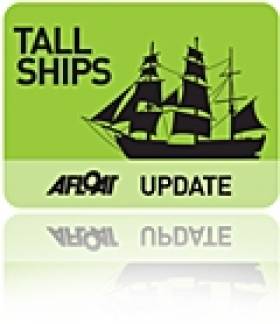Displaying items by tag: 'A' Class Tall Ships
Lord Nelson Heads for Waterford
As the Tall Ship STS Lord Nelson nears Carnsore Point off Wexford this evening the barque will be one of the many vessels participating in the Waterford Talls Ships Races Festival, writes Jehan Ashmore.
Joining Lord Nelson are three other UK entrants, they are the Jean de la Lune, Pelican of London and Royalist now celebrating her 40th anniversary. Together these tallships belong to the 'A' class vessels, the largest of the tallships. The impressive array of A class vessels includes four ships alone from The Netherlands with the Astrid, Eendracht, Europa and Wylde Swan, a schooner built in 1920.
From Norway is the fully rigged tallship Christian Radich and Sorlandet. The Poles are coming with their Pogoria. Neighbouring Russia are sending their impressive 108m long Mir which has 26 sails and has a 200-strong crew though the 1987 built vessel can be sailed with just 30. The final A class entrant is from outside Europe, the Columbian 1,300 tonnes Gloria, a three-master of over 60 metres long.
In addition to this exciting line-up are the 'B' and 'C' class which in total brings 45 tallships of all shapes and sizes to the quays of the River Suir. The crystal city will be host to over 1,000 trainess and over 400 professional crew who will take part in the colourful 'Crew Parade' held on Friday. For a full list of tallships and accompanying photos go to www.waterfordtallshipsrace.ie/the-race/the-tall-ships/
The spectacle of the festival will culminate in the early hours of Sunday when the fleet departs the city and heads downriver with a 'Parade of Sail' in the estuary of Waterford Harbour. As the tallships pass offshore of Dunmore East, this will mark the start of the first race-leg to Greenock.
The famous race is organised by Sail Training International (STI) a charity established to harness sail training to develop and educate young people, regardless of nationality, culture, religion, gender or social background.
The STI can trace its roots with the creation of the Sail Training International Race Committee which organised the first race of sail training tall ships in 1956. Their website is www.sailtraininginternational.org/
Waterford Tall Ships Races 2011 Participant Sails into Dublin
The Jubilee Sailing Trust's (JST) three-masted 'flagship' STS Lord Nelson arrived into Dublin today (Wednesday) as part of her sail-training programme. The barque is one of over 30 tall ships so far confirmed out of an expected 70 entrants for next year's Tall Ships Races starting from Waterford, writes Jehan Ashmore.
In the 'A' class tall ships (the large square-rigged vessels) the Lord Nelson will be sharing this category with a further six ships representing these impresssive vessels to include Christian Radich, Europa and the Polish Pogoria, which also called to Dublin recently.
The Lord Nelson will participate in the first race between Waterford and Greenock. From the Scottish port the tall ships will 'Cruise-In-Company' to Lerwick, the capital of the Shetland Islands. The race then crosses the North Sea to Stavanger, Norway and the final leg is to culminate in the Swedish west coast port of Halmstad in early August.
The Lord Nelson was designed by Colin Mudie and is specifically constructed to enable people of all physical abilities to sail side-by-side as equals. The vessel has an overall length of 54.7m and when under canvas (1,024m2) that's all 18 sails, Lord Nelson can achieve around 10 knots.
In addition to Lord Nelson, the JST which is run as a registered charity operates the SV Tenacious. Likewise this barque is designed for the same purpose and they can claim to be the only tall ships in the world having this distinction of providing sailing opportunities for all.
Since the charity started in 1978, over 36,000 people have sailed with the trust. Of those, over 24,000 people have sailed onboard Lord Nelson, which was launched in 1986, and 12,000 have sailed on Tenacious which was launched in 2000.
The countdown for the Waterford Tall Ships Races 2011 continues with less than 281 days to go!...The prestigious event is organised by Sail Training International in association with Szczecin.
Looking for further reading on Tall Ships in Ireland? Click the links below:
Click this link to read all our Tall Ships Stories on one handy page
Previewing Ireland's Tall Ships 2011 Season
Can Ireland Get a New Tall Ship?


























































